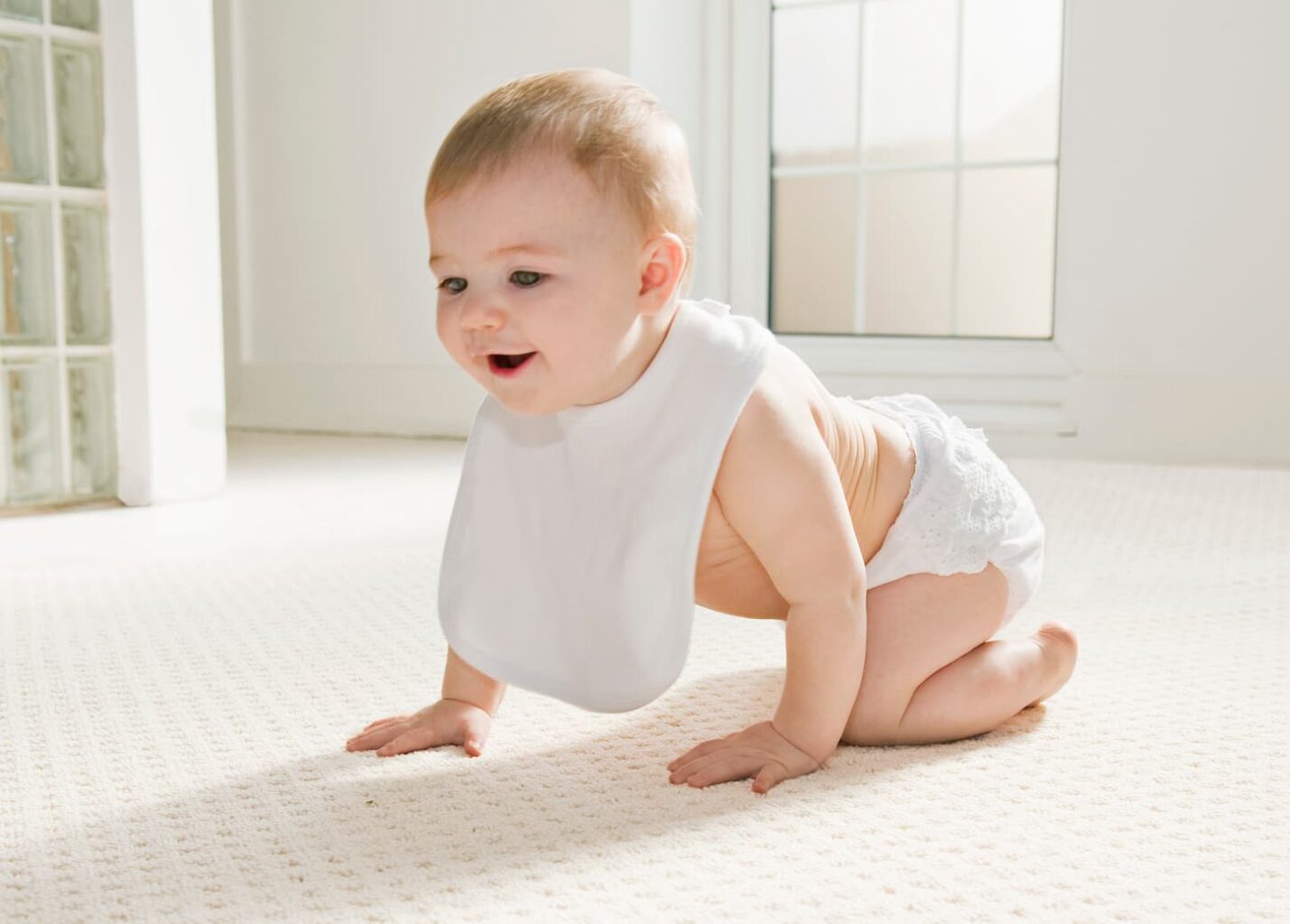Extreme frustration occurs when we’ve tried everything to get our babies to sleep. Swinging, swaddling, rocking, and all methods available, and yet our babies still keep us awake all night. So, what should we do? Well, read this article to find out.
A high-needs baby desperately needs a solid routine. Predictability is of the utmost importance. Choose one or two habits to create and stick with them. For example, giving them a soothing bath and putting them down in a calm, dark room can be good signals, so the baby knows it is time to rest.
Parents usually feel guilty in this situation, feeling they’re not good parents to their baby. A “high-needs baby” is not a diagnosis or a medical condition. It’s a term for babies full of energy who tend to be more emotionally and/or physically demanding. Want to know more about it? Let’s do this!

How Do You Put a High-Needs Baby to Sleep?
Keep the baby’s room cool and dark. Set a routine, such as a soothing bath and a lullaby before bedtime. It is better for a baby if they do not connect eating with sleeping, so try to feed them earlier.
Parents must arm themselves with patience to put a high-need baby to sleep.
We have tried every sleep-training method, but it seems impossible. This is expected because a high-needs baby requires a different approach since they are much more resistant to methods that work for an average child.
High-need babies not only need more encouragement to fall asleep but also to stay asleep. We’ll introduce some efficient tips and tricks to help parents and their high-needs babies get the rest they deserve.
Read below for some handy tips we suggest trying.
Create a routine
High-needs babies require predictability. Parents must plan their day and keep things as consistent as possible. Creating a routine for a baby is the most crucial strategy for a good night’s sleep.
Most parents argue that routines don’t work for their babies. Of course, this is true because high-needs babies are resilient and resist any routine.
But this doesn’t mean the baby can’t benefit from a carefully planned routine. In a study, researchers discovered that a well-organized sleeping routine benefits babies and their parents.
When both parents and babies have a good night’s sleep, it leads to a better and more positive mood for both.
So, how to create a sleep routine? It’s best to create a routine based on the baby’s preference. For example, parents and babies can have a 30-minute routine that consists of a soothing bath, a massage, and calming activities such as singing, reading, or cuddling.
Whatever your bedtime routine looks like, focus on the best thing that makes your baby sleepy. Don’t excite them too much; there should be no playtime before bed. Here’s more on sleep routines: Sleep Training Routine: a Guide to Ditch Sleepless Nights.
Whatever routine you choose, don’t forget to be consistent.
Exposure to natural light
We don’t hear much about this handy tip. Babies, especially high-needs babies, have their days and nights all mixed up. Exposing a baby to natural light throughout the day will help to restart their wake and sleep patterns.
When babies are born, they are unaware of the circadian rhythm. In other words, babies don’t know when to be awake or asleep. There was another study where it was discovered that babies who were exposed to natural light in the afternoons slept better at night.
How do parents do this? If possible, at the same time every day, go outside with the baby. Be sure to keep the blinds open in the baby’s room during their awake time. During naptime and bedtime, keep the baby’s room dark and cool.
Responding to baby’s night waking
Research (like this study) shows that instantly responding to a night wake will increase the baby’s frequency of waking up. Of course, this doesn’t mean parents shouldn’t respond to their baby’s crying.
When it comes to high-needs babies, they might need more encouragement and time to fall back asleep again.
We suggest waiting for a couple of minutes before immediately going in and comforting the baby. It’s surprising to find out that babies usually fall asleep by themselves.

What Sleep Routines Work Best for High-Needs Babies?
Babies need a lot of sleep, between 16 and 18 hours per day. Babies who struggle to fall asleep at night usually nap for too long during the day.
“Sleep begets sleep“- ever heard of this one? Simply put, if a baby sleeps better during the day, then they’ll sleep better during the night. The big secret is revealed! It makes a lot of sense.
Ready for more tips? Let’s go!
Naptime
The best advice we can give is to plan the day around the baby’s naps. They will fight the naps passionately, but it’ll be worth it. The game is over if they hear a slight sound and wake up.
Most parents make the same mistake and skip naps so their babies can sleep better at night. Don’t do that; the baby needs a nap. When the baby is overtired, it’s harder for them to fall asleep at night.
If a baby wakes up after only half an hour, put them back to sleep. Follow the routine meticulously. Before every nap, make certain the baby has some kind of activity. For example, take them outside and expose them to natural light.
Another tip is that babies need to have their place to sleep, free from distractions. Preferably in a calm and dark room.
Bedtime
Like naptime, bedtime also needs to have a routine. Try a warm bath or go for a walk. This will give the baby a hint that it’s time for sleep. A gentle massage will also do the trick, a very popular ritual before the baby’s bedtime.
Some parents like to feed the baby before, although this doesn’t work for every baby. Try it!
A baby should sleep in a dark room. Avoid any music or electronic toys nearby. High-needs babies are sensitive to sounds and noise.
Again, planning is key – unfortunately, there is no room for flexibility. Some parents have a strict two-hour bedtime routine.
Are There Any Commonly Used Sleep Training Methods That Work Best for High-Needs Babies?
Some common methods used for high-needs babies include removing any kind of distraction or stimuli from their room, incorporating an ‘Eat-Play-Sleep’ routine, and allowing the baby to cry (just a little bit to let out some energy).
Here are some techniques that will help parents. Getting a baby to sleep all through the night is quite a challenge. Every high-needs baby is different, so be sure to try every method there is to find the perfect one for the family.
High-needs babies are sensitive
High-needs babies are more sensitive to noise than the average baby. Most babies will keep on sleeping if they hear any sound or noise.
In this case, we advise parents to remove any stimuli from the room. Here are some examples: high-pitched toys, clocks, squeaky cribs, etc.
Nursing at night
Most moms nurse every time the baby wakes up at night. This depends on how old the baby is, of course.
The usual advice is to nurse a baby for food, not comfort. One of the greatest joys of motherhood is to nurse a baby to sleep, but sometimes, this is the easy way out.
Our suggestion is to try an Eat-Play-Sleep routine. This way, the baby will separate nursing from sleeping, giving them more time to digest the milk.
Want to know more about the eat-play-sleep routine? I’ve got a guide for you in this article: Baby Wake Times: a Beginner’s Guide to Wake Windows by Age.
Bedroom
The baby’s favorite place will be sleeping next to their parents, as they should. But high-needs babies want to sleep with their parents all the time.
Because they are not particularly good sleepers, when they wake up, all we need to do is reach out our hand and cuddle the baby back to sleep.
Some babies can only fall asleep with one of their parents in the room. In the beginning, parents should sleep with their baby. But after some time, create a routine to teach the baby to sleep alone in the bed.
In the meantime, our advice to keep your marriage healthy is to make some kind of arrangement where you and your partner will have a few hours together as a couple.
How Long Does It Take to Sleep Train a High-Needs Baby?
For some parents, high-needs babies take days to weeks to a few months or even a year. There is no “one size fits it all,“ but it will improve eventually with consistency, patience, and practice.
In this scenario, patience is the key. Even if we are the best parents in the world, our babies can bring us down to our knees.
To sleep-train a high-needs baby is a challenging task for sure. Parents and babies end up exhausted.
For this reason, we suggest looking at the situation from a different perspective. High-needs babies need more love and attention; they are babies who will teach us what parenting is in the best possible way.
Don’t forget that parenting involves teamwork. No matter how long the sleep training lasts, you can do this!

Key Takeaways and Next Steps
We hope this article comforted you and taught you some good-to-know facts. The most important thing to know is the difference between a high-needs baby and a fussy one.
High-needs babies are unpredictable, demanding, needy, full of energy, can’t sleep, won’t stop crying, and are extra sensitive.
We know high-needs babies don’t fall into routines by themselves; they need some support. With a strict routine, babies fall into sleeping patterns much more easily.
Of course, we advise parents to consult primarily with the baby’s pediatrician before anything else. In the end, all babies will fall asleep eventually. Love your baby, and don’t be too hard on yourself.
As parents, we want to know as much as possible about sleep-training our babies (and parenting in general!). Here are some articles we’ve written just for you on sleep-training methods for sensitive babies:
- Baby Won’t Sleep Unless Rocked? Here’s What to Do
- Can All Babies Be Sleep Trained? Do All Babies Need it?
- Get Help Sleep Training Your Baby (for under $10)
- Guide: How to Teach a Baby to Fall Asleep on Their Own
- What is Gentle Sleep Training (Everything You’ve Wondered)
They’re all great articles, so feel free to pick whichever one appeals to you now. You can always bookmark our site or use our search function to find whatever else you need. And if you don’t see exactly what you need? Use our contact page to ask – and we’ll get the resources you need to be added to this site ASAP.
Resources
Learning about parenting or sleep training techniques is important to learn from various reputable sources. These are the sources used in this article and our research to be more informed as parents.
- Flutie, Diana. “Three Ways To Help Your High Need Baby Sleep.” Big Sky Lullaby, 21 Oct. 2021, bigskylullaby.com/sleep-tips/high-need-baby-sleep/.
- Motroni, Amy. “Sleep Begets Sleep (How Naps Impact Your Baby’s Night).” The Postpartum Party, 25 Jan. 2022, thepostpartumparty.com/sleep-begets-sleep/.
- Sears, Bill. “6 Ways to Getting Baby to Sleep Through the Night.” Ask Dr. Sears, 22 Sept. 2020, www.askdrsears.com/topics/health-concerns/fussy-baby/high-need-baby/6-ways-help-high-need-baby-go-sleep-stay-asleep.
- The Fussy Baby Site. “Sleep Training A High Need Baby.” The Fussy Baby Site, 21 Jan. 2018, www.thefussybabysite.com/blog/sleep-training-a-high-need-baby.